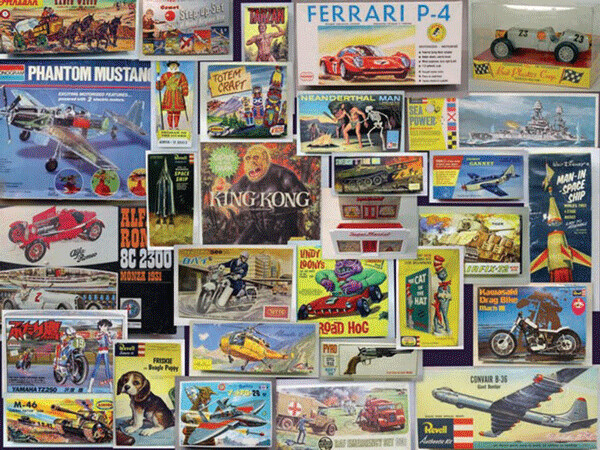Toys into Work

I was rummaging through things last week when I ran across a miniature anvil that had once been fixed to the work bench built during my model making days. Like a good many boys, I began with plastic models that required little more skill than getting the injection mold nubs off and not making too big a mess of the glue job. Poor work could be somewhat hidden by paint. If that went OK the final effect could be ruined if the decals got crooked. Most times, however, I’d make a mess of the cockpit. An otherwise passable plane looked offensively amateurish with even a single glue smear on the wind screen. For that reason I hated windscreens and sometimes left them out. This before-the-fact admission of defeat was hardly more appealing than a screen with glue smears. As an alternate to making trash of yet another model I decided I’d do better with a proper workshop. This consisted of a removable plywood base to sit on top of my study desk and a rack along the back to hold my precious X-Acto knives, miniature clamps, etc. I was prepared, but being better prepared didn’t bring better skill.
There is something in youth, however, that causes a young person to soldier on against odds. My production of junk models no way prevented me from believing the next would miraculously be a true beauty. As a confidence builder I threw in a few warship models. Having the sense to know I was not the boy to do sail ship rigging I did cruisers, destroyers, and battle wagons. How could I go wrong with battleship gray as the main theme with possible additions of bronze for the screws, tiny white dots on the major lights, and black dot ends for the big guns? I was seriously disappointed none of these ships was in the least seaworthy. I’d lug the entire fleet to the tub on bath night and haul it all back to bedroom dry dock. Water would seep from the hulls for days. This habit does not make good sense, but when you’re twelve a good many things one does are of little sense and less use other than being a necessity of the time.
My first decent plane was a Corsair, a fighter my father raved about and loved. Dad was a flier and one of my early memories is rummaging among abandoned airframes on the fringes of the Hinsdale Airport where I learned the balsa struts of some models roughly resembled the aircraft aluminum frames. I’ve not thought of this for a long time, but I suspect aircraft fuel is slightly intoxicating. It was to me. As I wandered among hangars (no one complained unless I messed with items on benches or tried to enter a cockpit) the sweet aroma of aviation fuel was strong in some areas faint in others, but always appealing. I think some of this aircraft appreciation seeped into my Corsair effort. I even managed a decent semblance of the two-tone hull with blue above and white underside. Dad was pleased, a sign (on the rare side) I’d done OK. Corsair success led to confidence. I’d do another plane, but not a Spitfire. The Spit was a good flier, but to me ugly. I did a Focke Wulf 190 and then a ME 109. Both are classic as the Corsair putting them (in my view) up alongside the Cadillac of the sky, the P 51 Mustang with styling to make an F 86 appear stodgy. I will tell you this, too. When a vintage prop driven fighter trainer revved to take off your body felt a different elemental shaking than the roaring blast of a jet. Each gets you off the ground, but the seat of your pants tells the difference.
The desktop workshop important to me through my mid-teens was long ago dismantled, its parts scattered like the anvil and rows of knives never used for classmate carving. The bits and pieces, though, represent and provided essential lessons that remain part of me. I surely felt good doing a decent model Corsair but I also knew that so doing didn’t represent a millionth of what was needed to construct a real plane and that dabs of glue and paintbrush skills brought no ability to get in a cockpit and fly the real thing. At base, at the foundation of possibility are realities of the limits of material and the skills to work within those frames. A genius on the computer may brilliantly design an innovation, but this leap will amount to little if there is no such material to work with, no tools able to produce it, or system of use that is free of other imperfections.
The process of finding solutions is never an easy one, but success will ultimately rest on more than optimism or desire. I certainly wanted my plastic fleet to mightily sail the bathtub sea, but that was never a possibility, was it? Is it not much the same with peace vigils and candlelight ceremonies? Are those things not but wishful and essentially useless fantasies for dealing with hard realities? Of course, if an aggressor comes perhaps bombarding them with peace symbols or flowers will deter onslaught. If that seems unlikely then equally improbable is the belief that positive, happy, community thinking will save the day. I say that because I doubt any happy thinker we might know is ready to recall the reality of November 13 only two years ago. Did you remember that on 11/13/15 the City of Light, Paris saw coordinated attacks? At the Bataclan Theatre over a hundred met reality as they were tortured and killed by attackers who playfully dragged bodies on the theatre floor to create a bloody finger painting. Real ships, real planes require more than model skills. Real challenges need a commitment above wishful thinking. That’s not pessimism. It’s a reality, one I don’t care for. If you also don’t like it we need to stand for something more useful than hopeful optimism.
